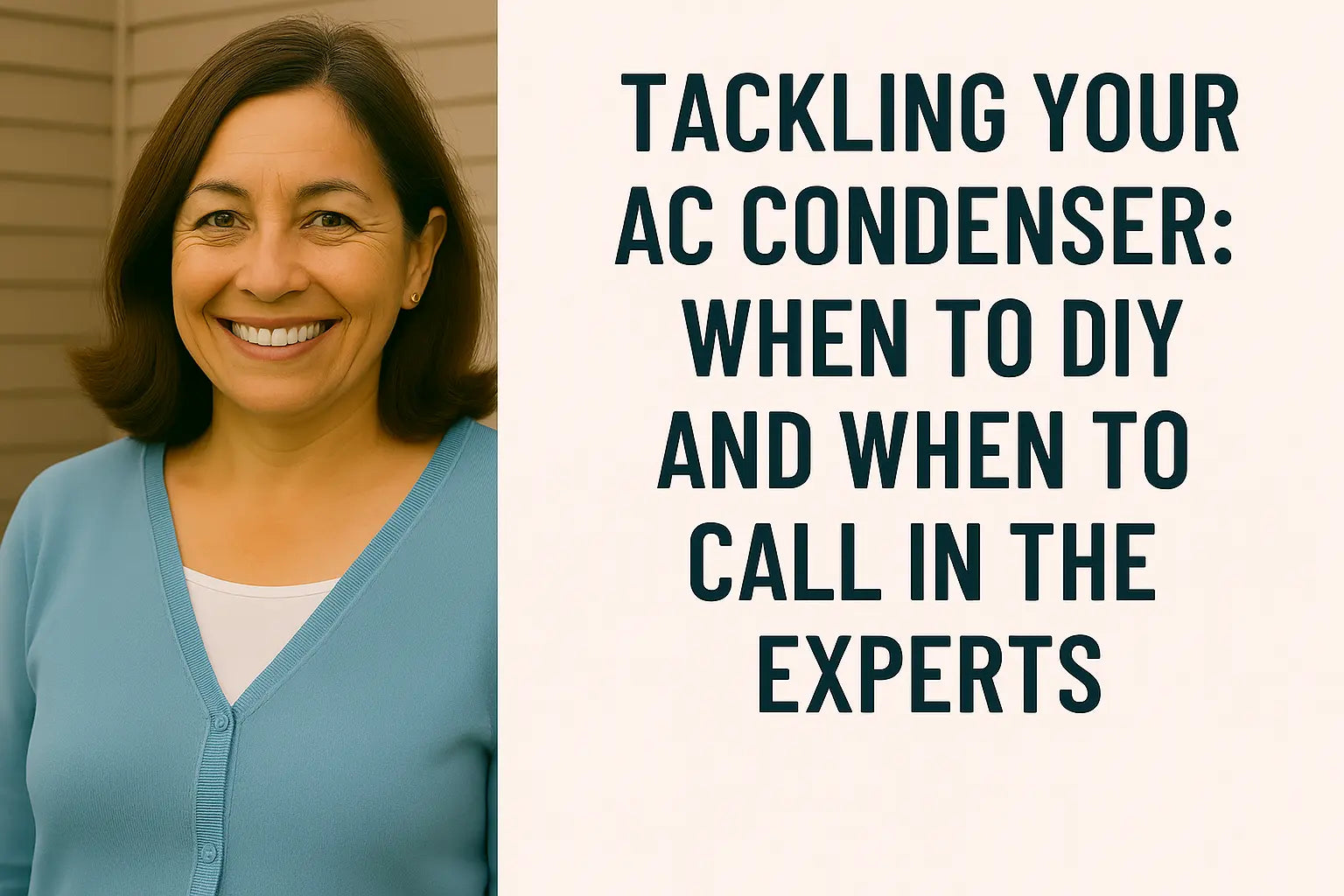Samantha’s Friendly Hello!
Hey friends, Samantha here! If you’re reading this, you’re probably staring at your aging AC condenser or dreaming about upgrading to a new R-32 unit and asking yourself: “Can I do this myself? Or should I hire a professional?” That’s a great question, and one I get all the time.
I love empowering homeowners with knowledge, but I’m also a realist who knows some jobs really do require specialized training, tools, and licenses. So today, I’m breaking down the truth about DIY vs. professional service when it comes to your AC condenser. We’ll talk about what’s involved, safety considerations, typical costs, and the potential risks and rewards. By the end, you’ll feel equipped to make a smart, confident decision for your home and family.
🛠️ What Does DIY for an AC Condenser Installation or Repair Involve?
Let’s start by looking at what a typical DIY project might look like for an AC condenser.
-
Removing the old condenser
-
Installing a new unit on a level pad
-
Connecting refrigerant lines (suction and liquid lines)
-
Running electrical wiring and installing disconnect switches
-
Evacuating air and moisture from the lines using a vacuum pump
-
Charging the system with refrigerant
-
Testing system operation
If you’ve never done this before, it’s a lot. Plus, it requires specialized HVAC tools and knowledge of refrigerants, electrical codes, and safety protocols.
⚠️ The Challenges and Risks of DIY AC Work
Refrigerant Handling
Most homeowners don’t realize that refrigerants, including R-32, are regulated substances. R-32 is mildly flammable (classified A2L), which means handling it improperly can be dangerous. The EPA requires anyone who handles refrigerants to be certified under Section 608.
If you’re not certified, you legally can’t purchase or work with refrigerants, and improper handling risks leaks, injury, or worse. Learn more about this at the EPA’s Section 608 technician certification page.
Electrical Hazards
AC condensers operate on high voltage (usually 208/230 volts). Incorrect wiring or bypassing disconnects can cause shocks, fires, or damage to equipment.
Tool and Skill Requirements
Specialized tools like vacuum pumps, manifold gauge sets compatible with R-32, and torque wrenches are essential. Improper evacuation or charging will hurt system efficiency and lifespan.
💡 When DIY Makes Sense for AC Condensers
DIY projects can be rewarding and cost-saving—but only if you have:
-
Previous HVAC experience or professional training
-
Proper tools and equipment
-
Willingness to follow all safety and code requirements
-
A simple project like swapping an identical replacement condenser with pre-charged refrigerant lines
If that sounds like you, great! Just be sure to consult the manufacturer’s installation manual and local building codes.
🧑🔧 When You Absolutely Need a Pro
Most homeowners will be better off calling in a licensed HVAC technician if:
-
The project involves refrigerant charging or recovery
-
You need to size and install new refrigerant lines
-
Electrical wiring modifications are required
-
You want a Manual J load calculation and professional system sizing
-
You want to qualify for manufacturer warranties and utility rebates (often require pro installation)
Certified pros bring experience, safety training, and access to the latest equipment. And their work is backed by warranties and code compliance. For help finding a trusted pro, check HVAC.com’s contractor directory.
💰 Comparing Costs: DIY vs. Professional AC Condenser Work
DIY Cost Considerations
-
New condenser unit (typically $1,500–$3,000)
-
Tools rental or purchase (vacuum pump, gauges, torque wrench)
-
Materials (line set, electrical parts, refrigerant if needed)
-
Potential permit fees
While you save labor costs, mistakes can lead to expensive repairs or early system failure.
Professional Installation Costs
-
Labor typically $1,000–$3,000 depending on complexity
-
Permitting and inspection included
-
Warranty coverage and post-install support
-
Peace of mind and safety
Utility rebates and manufacturer warranties often require professional installation for eligibility, which can offset costs. Explore rebate options at DSIRE’s energy efficiency incentives database.
🔧 DIY Tips if You Decide to Go For It
-
Study the unit’s full installation manual thoroughly
-
Invest in quality HVAC tools rated for R-32 systems
-
Pull a proper vacuum on lines to remove moisture before charging
-
Use a refrigerant scale for precise charging (never charge by pressure alone)
-
Always follow electrical code for disconnects, breakers, and grounding
-
Check local permit requirements and inspections
For detailed step-by-step DIY guides, HVAC School is a great resource with free courses and tutorials.
🛡️ How to Protect Your Investment Regardless of DIY or Pro
No matter who installs or services your condenser:
-
Schedule annual professional maintenance
-
Change air filters regularly
-
Keep outdoor unit clear of debris
-
Monitor system performance and energy bills for changes
Good maintenance extends equipment life and prevents costly breakdowns. For maintenance tips, see Energy Star’s guide to HVAC maintenance.
🏁 Samantha’s Wrap Up
There you have it, friends! Deciding between DIY and hiring a pro for your AC condenser is a big choice—one that balances cost, skill, safety, and peace of mind.
If you’re a confident DIYer with the right tools and knowledge, you might save money and enjoy the satisfaction of doing it yourself. But for most homeowners, especially when dealing with refrigerants like R-32 and electrical work, the safer and smarter choice is to call in a licensed pro.
Whichever path you choose, make sure to plan carefully, follow safety rules, and prioritize quality. And if you’re still shopping for your new condenser or need help finding qualified installers, visit The Furnace Outlet’s R-32 condenser collection.
Need more troubleshooting tips for your R-32 condenser? Visit my guide: Top 10 Error Codes on R-32 AC Condensers.
Stay savvy, stay safe, and stay cool!
💙 Samantha, Home Comfort Advisor







